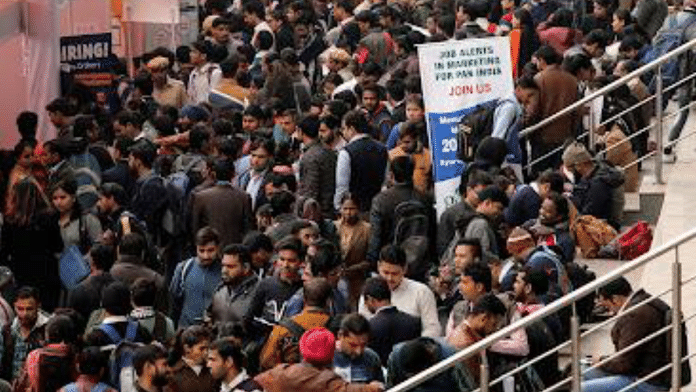Thank you dear subscribers, we are overwhelmed with your response.
Your Turn is a unique section from ThePrint featuring points of view from its subscribers. If you are a subscriber, have a point of view, please send it to us. If not, do subscribe here: https://theprint.in/subscribe/
Recently, the Institute for Human development on labour and employment issue along with the International Labour Organisation released the India Employment report 2024, which shows a complex more diametrically contrasting picture of the employment spectrum. It raises significant concern over the female LFPR (Labour force participation rate) which stands at 32.8% (2.3 times lower than the male LFPR) vs the World’s average at 47.3% in 2022, though it got increased between 2019 and 2022, surprisingly more than the male LFPR (by 8.3% vs 1.7%) particularly in rural areas after a steady decline (more than the male LFPR) from 2000-2019. This reversing trend has been seen in many of the components post-pandemic crises. This situation was also observable during 2005.
Hidden fault lines
Economists argue that the female participation in work force can succinctly be for short-term considering when their families happen to be in economic downturn situation and may opt out from the workforce later featuring the subsidiary employment rose significantly to 6.3% in 2022 from 2.8% in 2019, as per the report. This could be due to the lack of infrastructure for mothers to access proper childcare facilities as it is difficult for them to balance the work-family responsibilities. Further the informalization of work, as the report highlights, majority (90%) of the workers are informally employed exacerbating the already penurious employment generation, gender-wage gap, rural urban divide, deeply-rooted biases against women, social categorization etc. As Ambedkar’s saying goes “Caste isn’t a division of labour, it is a division of labourers”.
As the data explains, the self-employment remains the prepollent component in the India’s employment share that too subjugated by women workforce (62% vs men at 53.1%) amply in rural areas. Self-employment in the unpaid family work category is the most vulnerable one and alas it is where women are predominantly engaged in, which in fact got increased in from 2019-2022. Even in agriculture, women have a much larger share of 62.8% than men at 38.1% throwing light on the women’s unfaltering subsistence work in a sector where the minimum wage for the unskilled workers is the lowest (Rs. 300). At the all-India level, 40.8% and 51.9% of the regular and casual workers didn’t get their minimum wages prescribed, 2022, data shows.
A perennial issue
The workforce and the labour force before 2019 has been falling short of the population growth which after 2019 has not been the case up to 2022. The agricultural sector which merely contributes to 15-17% of GVA accounts for nearly 46% of the workforce. The trend after 2019 has not been much supportive of the other sectors as there was seen a mobilisation from the non-farm sectors to the farm-sector with a pace of 8.93% growth in agriculture. Most developed countries as stylized Kuznets-Lewis process hypothesize structural transformation from agri to manufacturing to services unlike the case of India. The manufacturing sector has been the most underperformed since decades and shows stagnant GVA contribution of 29-31% and consequently some eastern and central states like Bihar, Jharkhand, Odisha, Assam etc and Uttar Pradesh and Madhya Pradesh have poor employment outcomes in regular, formal and organized employment layout. Notwithstanding the lower creation for formalized employment, certain social strata face more fencing in accessing skill-based job.
A confound mismatch
Not considering the COVID-19 pandemic era, where every economy has paid its own costs and the structural pattern fractured. Albeit its repercussions were seen in the post-pandemic era. While the Indian government has since the last decade been focusing on the digital infrastructural push, the pattern of proliferation of the medium and high skilled jobs till 2019 has come to a halt and got reversed between 2019-2022 indicating people rush more for low-skilled, the pandemic effect has it. As industry 4.0 technology evolves and eventually encompassing medium and large sized industries, subordinating the low to no skill jobs among youths, but this trend actually reversed in the post pandemic state of affairs. The automation cost is more in developing countries like India where the low-wage demanded lion’s share of labour needs to be succumbed. There have been wide educational disparities largely among educated youth, segmented by regions, class and other invisible social barriers, in the quality of education required to learn the necessitate skills to get absorbed in the medium to high paying job outline, manifesting persisting gender and rural-urban gap in technical education. Albeit the gender imparity in education particularly for women in graduation and higher qualifications has decreased and women now have a slightly higher edge over men by 0.3% in 2022, the report highlights. With considerable regional gap and rural-urban disparateness remains with declining learning achievements, annual status of education report 2023. A growing number of youths in the labour force and providing jobs to the previously unemployed or underemployed as well as the future aspirations is pronouncedly a colossal of policy work required to match the labour-market uncertainties.

